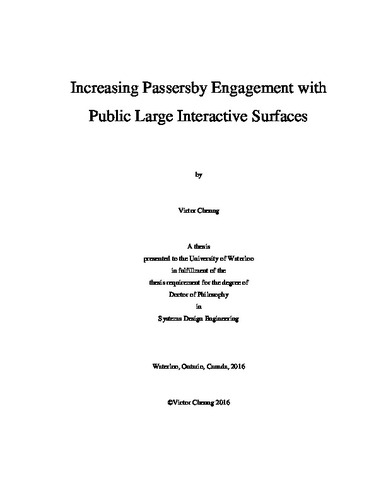| dc.contributor.author | Cheung, Victor | |
| dc.date.accessioned | 2016-08-17 18:51:16 (GMT) | |
| dc.date.available | 2016-08-17 18:51:16 (GMT) | |
| dc.date.issued | 2016-08-17 | |
| dc.date.submitted | 2016-08-17 | |
| dc.identifier.uri | http://hdl.handle.net/10012/10648 | |
| dc.description.abstract | Despite the proliferation of Public Large Interactive Surfaces (PLISs), and their potential to provide a more engaging and interactive user experience, these surfaces often go unnoticed by passersby, or not immediately comprehensible in terms of usage. Current research in addressing this problem involves modeling the user-surface interaction through observational studies, and deriving recommendations for interface design to facilitate the interaction. This approach is often context-specific, requires elaborate setup, and lacks experimental control. To mitigate this problem, an interaction model, named DISCOVER, was developed by drawing ideas from classic usability research and focusing on the discoverability aspect of the interaction. This approach allows the model to serve as a lens for understanding and synthesizing existing work on PLISs, and to be used as an evaluation framework to assess effectiveness of potential designs. To accompany this evaluation capability, a laboratory-based evaluation methodology was developed to allow researchers to quickly implement and evaluate potential designs, particularly for the early stages of interaction that precede the more commonly studied explicit and direct interaction (e.g., touches, mid-air gestures).
Using the model and the evaluation methodology, a proximity-based interaction mechanism using animated content and shadow visualizations was designed and evaluated as an effective technique in drawing attention from unknowing study participants. A follow-up, more conventional in-the-wild study also verified this finding, and further demonstrated the usefulness of shadow visualizations in drawing attention from passersby, retaining them, and enticing playful interaction.
The goal of this thesis is to better equip researchers and practitioners of PLISs with tools that allow them to evaluate and improve existing interfaces, and to provide them with insights into designing future ones employing better and more engaging technologies. | en |
| dc.language.iso | en | en |
| dc.publisher | University of Waterloo | en |
| dc.subject | Human-Computer Interaction | en |
| dc.subject | Public Large Interactive Surfaces | en |
| dc.subject | Interactive Systems | en |
| dc.title | Increasing Passersby Engagement with Public Large Interactive Surfaces | en |
| dc.type | Doctoral Thesis | en |
| dc.pending | false | |
| uws-etd.degree.department | Systems Design Engineering | en |
| uws-etd.degree.discipline | System Design Engineering | en |
| uws-etd.degree.grantor | University of Waterloo | en |
| uws-etd.degree | Doctor of Philosophy | en |
| uws.contributor.advisor | Scott, Stacey | |
| uws.contributor.advisor | Lank, Edward | |
| uws.contributor.affiliation1 | Faculty of Engineering | en |
| uws.published.city | Waterloo | en |
| uws.published.country | Canada | en |
| uws.published.province | Ontario | en |
| uws.typeOfResource | Text | en |
| uws.peerReviewStatus | Unreviewed | en |
| uws.scholarLevel | Graduate | en |

